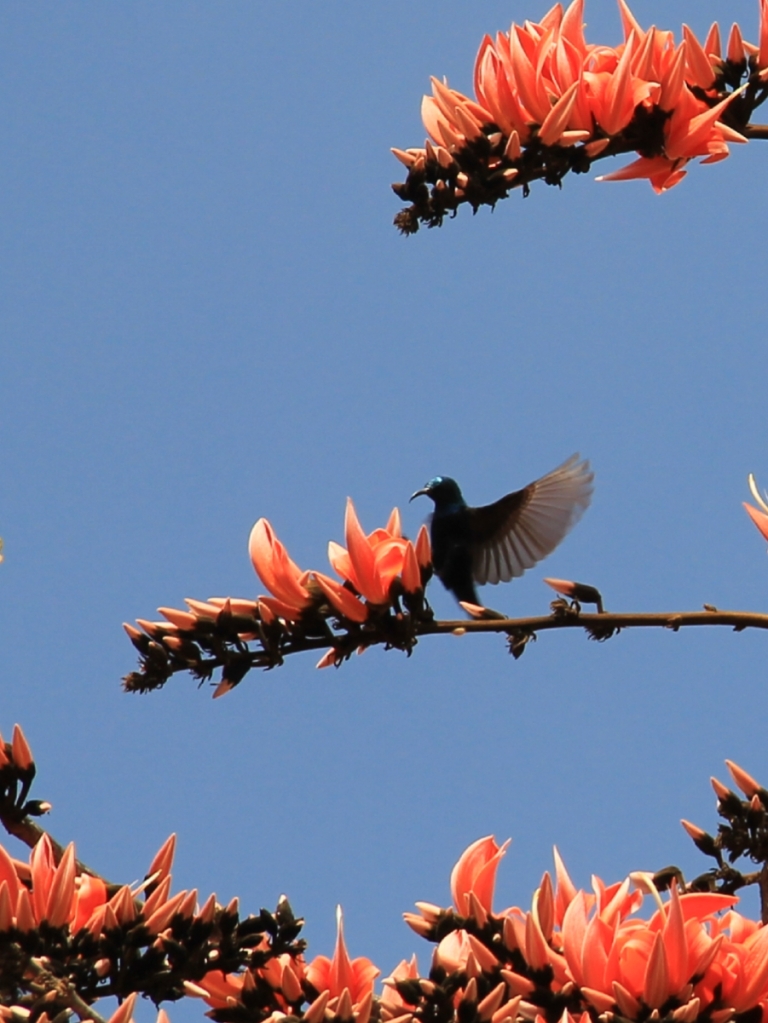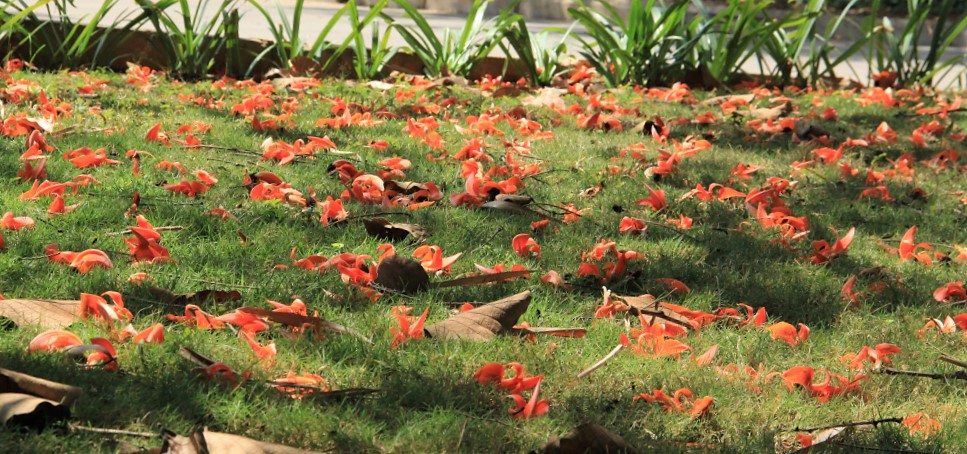
Truly, nature ‘spring’s to life in all its glory – a riot of colours, a heady blend of fragrances, chirping of birds, humming of bees, frolicking butterflies… Gurudev couldn’t be wrong, it is truly intoxicating!
Ektuku choya lage, ektuku kothai shuni
Tayee diye mone mone rochi mamo phaalguni.
Kichchu palasher nesha, kichu ba chapaye mesha
Tayee deeye shure shure range rashe jaal buni
A light touch do I feel, a few words do I hear
And I conjure in my mind spring’s full moon
The intoxicating red of ‘palash’, blend with fragrance of champa
I weave with music into a net of colour and fervour
– Rabindranath Tagore *

Driving through India’s dry deciduous forests during this season, across the Deccan (Telangana-Marathwada), the Western ghats of Sahyadris, Aravallis at NCR, Rajasthan and Gujarat, and gardens of Bangalore, an unmistakably common view of scarlet horizons. n bloom now, the forests and many urban gardens appear to be afire! The flowers of Palash and Spathodea splashing scarlet across the horizon…
Here, a Purple Sunbird is about to take a sip off the flowers nectar; birds like this one and are the major pollinators of the Palash, including the Indian Rose-ringed Parakeets.
Vasant rtu starts shortly after Makara Sankranti, the harvest festival and the movement of Sun God into the zodiac sign of Capricorn. After the winter solstice in December, the days become longer, sun starts shining brighter and winter chill is on the wane. Hindu Gods are awake now in Uttarayan, and Vasant Panchami is celebrated heralding the official arrival of spring, across India.
Flame of the Forest, Tesu/Dhak (Hindi) Muttuga (Kannada), Moduga (Telugu) is the state flower of Jharkhand (literally meaning-an area of trees!) and Madhya Pradesh. Historically, Palash forests are said to cover much of the doab between the Ganga and Yamuna rivers, central and western India; these were cleared for farming in early 19th century, for East India Company’s increasing tax demands on the farmers. It’s variously used for timber, resin, medicine, and dye.
As Latin is common in Botany, its referred to in as frondosa (leafy) monosperma (single seed) and Butea, after John Stuart (3rd Earl of Bute, PM of Britain 1762-3), finally named Butea monosperma. Two other colours of this flower occur – white and cream-yellowish – which are quite uncommon.
The medium-sized (15m), fast growing, long living native Indian tree, needs little water, can tolerate drought, frost and saline soils; It has a greyish bark, crooked stem and irregular branches. The wood is white and soft, being water-durable used for well-curbs and water scoops and boats; produces good quality charcoal. Trifoliate (3-leaf-cluster, believed yo be the Holy Trinity), its large leathery leaves are unfit for fodder, but are put to good use as food plates and cups. Bengal Kino is a red-gum extruded from the tree (infested with lac-insect produces shellac) used in tanning leather and polishes, and as an astringent in pharma. Orange-colour obtained from flowers used to dye cotton fabric (of monks traditionally). Flowers are collected, soaked and the pale coloured water is used to play Holi in North India; now it is making a comeback as organic colour in powder form. Its wood is also used to make implements for sacrificial fires for initiating the fire itself. Leaves are also used to roll bidi.

Quite modest all year round, Jan~Mar is when it comes alive – in bright crimson! Sunbirds of all colours and sizes, Parrots, Mynas, Squirrels blearily running up and down the branches in gay intoxication, butterflies and bees buzzing around – pictures a whole ecosystem that’s thriving on the tree during this season! Trees like Palash, Semal, Coral tree, that rely mostly on birds for pollination are early in the flowering season, have large reddish flowers and mostly do not compete for attention; even if climate plays-up as in recent times, there’s so much in abundance that it hardly makes a difference. The trees that flower in purple, blue, yellow, pink and other colours follow and rely largely on insects like bees and butterflies for pollination, of course small birds.
Kimshuka (Sanskrit), means like a parrot, it is mentioned in various literary works and puranic legends, and as early as 4 BCE by Panini; many parts of the tree are used in vedic rituals and sacrificial fires and is considered sacred for Pointiffs. In Ayurveda, the tree is referred to as Brahmavrksha. The tree and its flower have numerous medicinal properties. For eg. Bathing in water boiled with the flowers can cure skins problems. Various parts are used for stomach ailments, The reddish-orange flowers are offered to Kali and to Shiva.
The tree is referred to as “Susravas”, meaning a tree with the best hearing ability. In Vedas it is mentioned, “DevAvai brahmannavadanta tatparna upAsruNot susravAvai namh”, meaning: A student should be able to grasp the teachings of the Guru in the Gurukula, just as the Palasa tree.
Palash is beneficial to ecology. It reduces about 75% of dust from one cubic litre of the atmosphere. It also acts as an air conditioner by liberating 10-20 litres of water per day per tree of average height through transpiration. A fully grown tree of 15+ yrs is a good carbon-sink and since it sheds leaves adds to biomass that enriches and balances the soil composition. It is also used to stabilize field bunds (said to hold water and so not cut-down)? and make saline soils suitable for other trees! Palash also can aspire 10~20 liters of water daily into the atmosphere, and so its environs are cool.
Tribal wealth: Tribals, the natives of India’s jungles place a lot of importance to nature, especially trees and water. in Jharkhand, Santhal and Sabar tribes value Palash immensely. Santhals make ropes of its fibrous back and roots and in making boats. In Manipur, a piece of wood is buried along with the dead, or if the body isn’t available, a log of the wood is buried/burnt! Tribal areas of Maharashtra and adjoining Chhattisgarh, value Palash as the best coolant, with nutritional and healing qualities; the tradition of consuming flower’s extract is forgotten, few older people still reminisce. During summer, cold infusion of the dried flower is consumed as sherbet, while a tea prepared with dried flower and leaves can be consumed all year long (beneficial for urinary and menstrual problems). Fresh leaves are placed on the head and secured to avoid sun-stroke.
Lakhs from Lac: Tribals in MP’s Shahdol dist were taught to harvest Lac from the Palash trees, which then grew in popularity and has revived as a popular farming practice. Historically, the princely state of Rewa, which gave refuge to Mughal king Akbar as a kid, was the first to establish India’s a Shellac factory, in 1903 by Raja Gulab Singh at Umaria in Shahdol district. Now, since its revival, Jharkhand and MP vie with eachother in its produce. India is the global leader in exporting Lac (used widely in wood polish, ornaments like bangles, ammunition, airplanes, perfumes and little toys). commercially, a kg of Lac costs Rs. 800, and yearly revenues rustle up to US$43.3 million in 2018-19! 90% of Lac resin is produced from Palash, Ber and Kusum trees, as well as blackseed grass.
‘Dhak ke teen paat’ in Hindi refers to its trifoliate (3) leaves cluster. A Marathi proverb translated means – one will not become poor as long as the tree is alive – referring to its immense value in native knowledge.
In literature: Many poets were inspired by the Palash, and referred to it as a symbol of love from Valmiki to Jayadev to Tagore; Chanakya, referred to beauty and lack of fragrance says:
| रूपयौवनसम्पन्ना विशालकुलसम्भवाः। विद्याहीना न शोभन्ते निर्गन्धाः किंशुका यथा॥ | Though people be endowed with beauty and youth and born in noble families, yet without education they are like the Palas flower devoid of fragrance |
Shantiniketan, where Gurudev Rabindranath Tagore spent a lot of his childhood, had a many flowering trees, so unsurprisingly, ~60 trees are mentioned in his poems; of them, Palash in ‘Ore Grihobashi’ written in 1931 exhorts people to enjoy the Spring season – an excerpt:
| Ore grihobaasi! Khol, daar khol, laaglo je dol. | Oh people! Open the doors! There is a spring stir! |
| Sthale jale banotale laaglo je dol! | On soil, in water and the forests, there is a mad, spring stir! |
| Daar khol, daar khol! | Open the doors! |
| Ranga haasi rashi rashi ashoke palaashe, | A ruddy, laughter in abundance, amongst the ashok and palash flowers. |
| Ranga nesha meghe mesha probhato-aakashe, Nobino paatay laage ranga hillol. | An intoxication amidst the clouds of the morning sky With new leaves leaving a bright splendor, |
| Daar khol, daar khol! | Open the doors, open the doors! |
Palashi is a village in east of West Bengal on the banks of Hooghly (Bhagirathi tributary) river, named due to a large grove of the Palash trees. The legendary Battle of Plassey (anglicized of Palashi) occurred near this village on June 23, 1757, where Nawab Siraj-ud-daulah lost to the treachery of Mir Jaffar and Robert Clive’s army of British East India Company – paving the way for their Empire and to rule India for the next 190 years.
Maharshi Valmiki in his epic, The Ramayana, Rama converses with Sita
AdIptAniva vaidehi sarvataH puShpitAnnagAn .
svaiH puShpaiH kiMshukAnpashya mAlinaH shishirAtyaye
O Sita, behold the Kimshuka trees, with their brilliant flowers blossoming all over as if they are blazing up this winter!
From setting fire to forests, to hearts, and to sacrificial havis, from resembling the blood of Rama, Lakshamana and Indrajit, to the soulless beauty dyeing saints’ clothes, to mirthful colours of holi, to parrots and poets, from medicines to pleasing the moon, Palash has appealed variously with intensity since time immemorial.
This brilliant tree must furrow back into our gardens, into the urban landscape, rather than being relegated to folklore.

